Oerlikon KBA
The Oerlikon KBA is a 25 mm (25×137mm) autocannon, developed as a close range weapon for the mechanized battlefield originally made by Oerlikon-Bührle (renamed as Rheinmetall Air Defence AG following the merger with Rheinmetall in 2009).
| Oerlikon KBA 25 mm | |
|---|---|
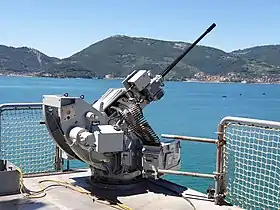 Oerlikon KBA 25 mm automatic cannon (Remote controlled weapon station) | |
| Type | Autocannon |
| Place of origin | |
| Service history | |
| In service | Mid 1970s – present |
| Used by | See operators |
| Production history | |
| Designer | Oerlikon Contraves AG |
| Manufacturer | Rheinmetall Air Defence; Ford Motor Company (designated KBA-B02 under license agreement with Oerlikon and TRW Inc. as a competitor to Hughes' Bushmaster)[1] |
| No. built | 4,000+ |
| Specifications | |
| Mass | 112 kg (247 lb) |
| Length | 2,888 mm (113.7 in) |
| Width | 263 mm (10.4 in) |
| Height | 283 mm (11.1 in) |
| Shell | NATO 25×137mm |
| Caliber | 25 mm |
| Rate of fire | Nominal: 600 rounds/min, Maximum: 700 rounds/min |
| Muzzle velocity | 1,400 m/s (4,600 ft/s) |
| Effective firing range | 3,020 m (9,910 ft) |
| Maximum firing range | 5,850 m (19,190 ft) |
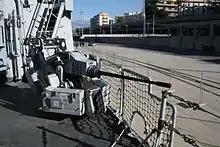
The Oerlikon KBA is a gas operated selective fire weapon taking a 25 mm cartridge from a dual selective belt feed and firing at a rate of 600 rounds per minute, it has been developed as a close-range multipurpose weapon for the modern battlefield.
Due to its firepower, various types of ammunition and its "Instant Ammunition Selection Device" (IASD), the KBA can engage lightly armoured vehicles, infantry and anti-tank positions, helicopters, combat aircraft and ships.
Description
The Oerlikon KBA 25 mm cannon is a fully automatic, positively locked, gas-operated weapon with a rotating bolt head and double belt feed. These features guarantee high reliability and safety, even under the most extreme environmental conditions.
The KBA offers a wide range of firing modes: single shot; programmable rapid single shot with a rate of fire of up to 200 rds/min; and full automatic fire of 600 rds/ min. The cannon functions, such as cocking and firing, are electrically actuated by remote control unit or in auxiliary mode mechanically by a hand crank and a trigger pedal.
The Oerlikon KBA 25mm cannon has been designed for integration in various types of mounts, small size and low weight offer various integration possibilities such as:
- Manned (1 or 2 operators) or remote controlled turrets on IFVs, APCs
- Air defence gun mounts
- Naval mounts
- Helicopter mounts
The various types of available ammunition combined with the unique Instant Ammunition Selection Device (IASD) and different selectable firing modes with a rate of fire up to 600rds/min support any type of operational use.
History
In 1964 the American company TRW Inc. was entrusted with the development of a 25 mm weapon while Oerlikon-Buehrle Machine Tool Works assumed responsibility for developing the ammunition and interior ballistics for it.[2]
The project of the new 25 mm Auto Cannon was originally named as "TRW 6425" and was originally developed by the famous American firearms designer Eugene M. Stoner.
The TRW requirement of the project was: the gun have to be fully automatic and actively locked, operated by pneumatic and revolving bolts and uses a bidirectional feed system, the cannon need to switch quickly and easily in different type of ammunitions. These characteristics ensure that it is highly reliable and safe even in the most extreme environmental conditions.
At the beginning of 1967, technical tests and firing trials were carried out with the first two American TRW-6425[3] prototype cannons at Oerlikon-Buehrle Machine Tool Works followed by the first demonstrations for another NATO country.
Both were intended to meet the requirements for the armament of infantry fighting vehicles of the 80's and 90's:
- Ammunition performance: 25 mm armour steel, 60° (NATO) angle of impact, 1000m range, corresponding to the armour of a well-armoured infantry fighting vehicle.
- "Instant ammunition selection" for engagement of different targets
- Selectable firing mode: Accurate single shot, bursts with a rate of fire of more than 550 rds/min for engagement of aircraft
- Compact structure: with low weight for installation in gun turrets of APC's
- Simple to operate: and service in the hands of infantry
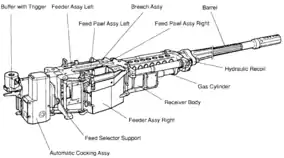
In the trials, however, the American prototypes displayed a number of basic functional deficiencies. This persuaded Oerlikon-Bührle Machine Tool Works to undertake their own development work to effect system modifications, which then resulted in the required functional reliability and enabled the trials to be completed successfully. (1970, 10 gas-operated cannons). When the first prototype cannons became available, suitable gun turrets had also to be provided. In 1967 an agreement was signed between Machine Tool Works Oerlikon-Buehrle and a well-known and established sub-contractor, to collaborate in the development and manufacture of 25 mm gun turrets. These gun turrets were in the first instance to be suitable for mounting on M113 armoured personnel carrier C&R of a NATO country's army. The complete system, cannon, hand-driven turret and ammunition underwent detailed firing trials between 1969 and 1971. Special new development efforts were devoted to improve functional reliability, durability and firing precision, and in 1971 sufficient progress had been made for the weapon system to fulfil the strict specifications laid down, and to be delivered to the Netherlands.
Within the framework of the product support service Oerlikon improves the product and adapts it regularly to the latest requirements. An important step forward was made in 1982/83 when the ammunition penetration performance range of the 25 mm APDS-T (sub-caliber) round was increased 150% from 1000 to 2500 m.
The wide range of strong points of the Oerlikon KBA 25 mm cannon, such as high rate of fire, ammunition performance, good safety record, dual belt feeder with first-round response, no external power requirement and simple maintenance lead to a considerably increasing interest in the Oerlikon KBA 25 mm cannon in years.
Ammunition
A wide range of ammunition has been developed for this weapon specifically developed to engage and defeat both ground and air targets.
The ammunition complies with all handling and operational safety requirements according to MIL-STD’s, and was subjected to intensive trials by NATO member countries prior to its introduction and standardization as NATO 25mmx137 ammunition.
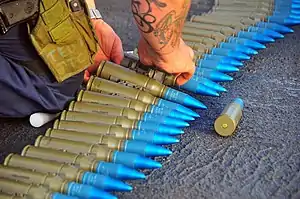
The current 25mm ammunition family consists of six combat and two training rounds:
- APFSDS-T: armour-piercing fin stabilized discarding sabot with tracer, for use against armoured ground targets
- APDS-T: armour-piercing discarding sabot with tracer, for use against armoured ground targets
- FAPDS-T: frangible armour-piercing discarding sabot with tracer, for use against air, ground and urban targets
- TPDS-T: target practice discarding sabot with tracer, a short range trainer for the above sub-calibre types
- SAPHEI-T: semi-armour-piercing high explosive incendiary with tracer, for use against well protected targets
- HEI-T: high explosive incendiary with tracer, for use against lightly protected targets
- MP-T: multipurpose with tracer
- TP-T: target practice with tracer, for training with the above full calibre types
Operators
Current operators
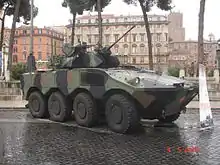
 Bangladesh
Bangladesh
 Turkey
Turkey
- ASELSAN 25 mm STOP Stabilized Naval Gun System[4]
 Egypt
Egypt Italy
Italy
- FREMM multipurpose frigate (x2 KBA System)
- LHD Trieste Aircraft Carrier (x3 KBA System)
- CVH 550 Cavour Aircraft Carrier
- VBM Freccia infantry fighting vehicle
- SIDAM 25 self-propelled anti-aircraft gun
- Horizon-class frigate
 Japan
Japan
 Netherlands
Netherlands Chile
Chile Romania
Romania
- MLI-84 tracked infantry fighting vehicle
 Bahrain
Bahrain Turkmenistan
Turkmenistan Malta
Malta
References
- Fiscal Year 1977 Authorization for Military Procurement, pt.6, p. 3268.
- Fitchett, Bev (2020-04-19). "Mm Trw Automatic Cannon - Machine Gun V5". Bev Fitchett's Guns Magazine. Retrieved 2020-05-11.
- "Mm Trw Automatic Cannon - Machine Gun V5". www.bevfitchett.us. Retrieved 2017-03-30.
- "Aselsan STOP 25mm Remote Weapon Stations for Pakistan Navy Fleet Tanker Project". Navy Recognition. Retrieved 2017-03-30.
